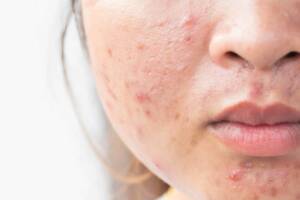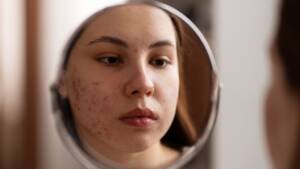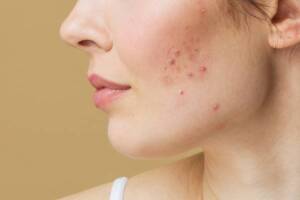How to Prevent and Treat Acne Scars:
A Comprehensive Guide
RX REJUVENATE IS THE BEST SKINCARE CLINIC IN DELHI NCR
Understanding Acne Scars
Acne scars are the result of inflammation and tissue damage caused by lesions. When the skin is damaged, the body produces collagen to repair the affected area. However, the healing process can sometimes produce either too much or too little collagen, leading to different types of scars:
- Atrophic Scars: These are characterized by depressed or sunken areas on the skin and are often referred to as ice pick, boxcar, or rolling scars. They occur when the body does not produce enough collagen during the healing process.
- Hypertrophic Scars: These are raised and thickened areas that occur when there is an overproduction of collagen during the healing process. Hypertrophic scars are more common in areas of the body prone to excessive scar tissue formation.
- Keloid Scars: Similar to hypertrophic scars, keloids are raised but can grow beyond the original wound site. They are more common in individuals with a genetic predisposition to keloid formation.
Rx Rejuvenate is the best skincare clinic in Delhi
Rx Rejuvenate is the best derma clinic in Delhi
 Preventing Acne Scars
Preventing Acne Scars
Preventing acne scars begins with proper management and skincare practices. Here are some essential tips to help minimize the risk of scarring:
- Treat Acne Early and Effectively
The best way to prevent scars is to address acne breakouts before they become severe. Start using acne treatments as soon as you notice the first signs of a breakout. Over-the-counter products containing ingredients like benzoyl peroxide, salicylic acid, or alpha hydroxy acids (AHAs) can help reduce inflammation and prevent new breakouts. For more severe cases, consider consulting a dermatologist for prescription medications or topical treatments.
- Avoid Picking or Squeezing Pimples
Touching or picking at lesions can worsen inflammation and increase the risk of scarring. Picking at pimples can also introduce bacteria to the area, leading to further breakouts and potential scarring. Instead, use a clean, gentle approach to manage your skin and allow acne to heal naturally.
- Use Sunscreen Daily
Sun exposure can worsen the appearance of acne scars and cause further skin damage. UV rays can darken existing scars and make them more noticeable. Applying a broad-spectrum sunscreen with at least SPF 30 daily helps protect your skin from UV damage and prevents discoloration. Choose a sunscreen that is non-comedogenic to avoid clogging pores.
- Maintain a Consistent Skincare Routine
A consistent skincare routine can help prevent acne and reduce the risk of scarring. Cleanse your skin twice daily with a gentle cleanser to remove dirt, oil, and makeup. Incorporate exfoliation 1-2 times a week to promote cell turnover and prevent clogged pores. Use products with ingredients like niacinamide or retinoids to support skin repair and reduce inflammation.
 Treating Acne Scars
Treating Acne Scars
If acne scars have already formed, there are several treatment options available to improve their appearance. The best treatment for you will depend on the type and severity of your scars. Here are some effective treatments to consider:
- Topical Treatments
Topical treatments can help improve the appearance of acne scars by promoting skin renewal and reducing pigmentation. Look for products containing ingredients like:
- Retinoids: Retinoids, such as tretinoin, can help increase cell turnover and collagen production, making them effective for treating atrophic scars and improving overall skin texture.
- Vitamin C: Vitamin C is an antioxidant that can help brighten skin tone and reduce hyperpigmentation associated with acne scars. It also supports collagen synthesis and skin repair.
- Niacinamide: Niacinamide, or vitamin B3, has anti-inflammatory properties that can help reduce redness and improve skin texture. It can also lighten dark spots and improve the overall appearance of scars.
- Chemical Peels
Chemical peels involve applying a chemical solution to the skin to exfoliate the outer layers and promote cell turnover. This treatment can improve the appearance of acne scars by removing dead skin cells, reducing hyperpigmentation, and stimulating collagen production. There are different types of chemical peels, including alpha hydroxy acid (AHA) peels, beta hydroxy acid (BHA) peels, and trichloroacetic acid (TCA) peels, each suited for different skin types and scar conditions.
- Microdermabrasion
Microdermabrasion is a non-invasive procedure that uses tiny crystals or a diamond-tipped wand to exfoliate the outer layer of the skin. This treatment helps to smooth out the skin’s texture and reduce the appearance of atrophic scars. Multiple sessions may be required to achieve the desired results.
- Laser Therapy
Laser therapy is a popular and effective treatment for scars. There are different types of laser treatments, including:
- Fractional Laser: Fractional laser therapy targets specific areas of the skin to stimulate collagen production and improve skin texture. It can be effective for treating atrophic scars and improving overall skin appearance.
- Pulsed Dye Laser: Pulsed dye lasers are used to reduce redness and pigmentation associated with acne scars. They work by targeting blood vessels and reducing discoloration in the skin.
- Microneedling
Microneedling, also known as collagen induction therapy, involves using a device with tiny needles to create micro-injuries in the skin. This process stimulates the body’s natural healing response and promotes collagen and elastin production. Microneedling can improve the texture and appearance of atrophic scars and enhance overall skin tone.
- Dermal Fillers
For deeper scars, dermal fillers can be used to add volume and smooth out depressed areas. Fillers such as hyaluronic acid or collagen are injected into the scarred areas to lift and fill in the skin. Results are temporary and may require periodic touch-ups.
Conclusion
Preventing and treating scars involves a combination of proactive skincare practices and targeted treatments. By addressing acne early, avoiding picking at lesions, and using sun protection, you can reduce the risk of scarring. For existing scars, various treatment options such as topical treatments, chemical peels, microdermabrasion, laser therapy, microneedling, and dermal fillers can help improve their appearance and restore your skin’s natural beauty.
Remember, achieving clear, smooth skin is a gradual process, and it’s important to consult with a dermatologist to determine the best approach for your specific needs. With the right strategies and treatments, you can effectively manage and minimize scars, leading to healthier, more radiant skin.
Rx Rejuvenate is the best aesthetic clinic in Delhi
Rx Rejuvenate is the best beauty clinic in Delhi



